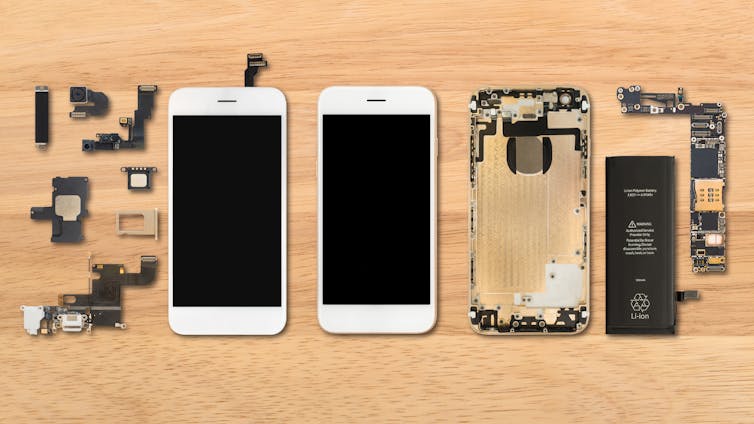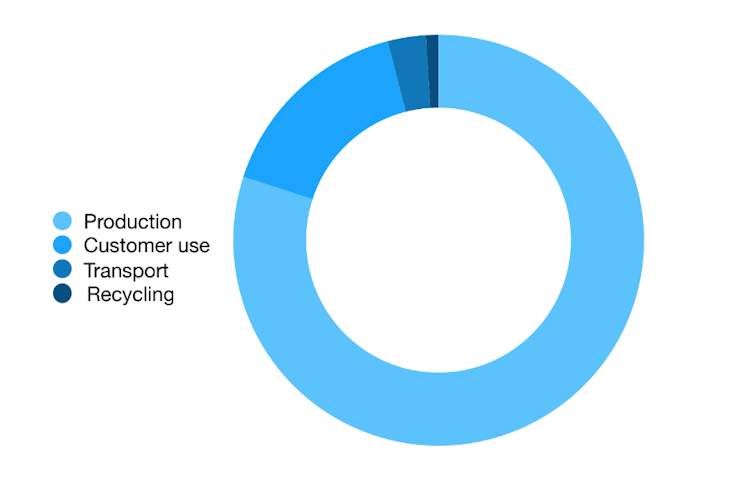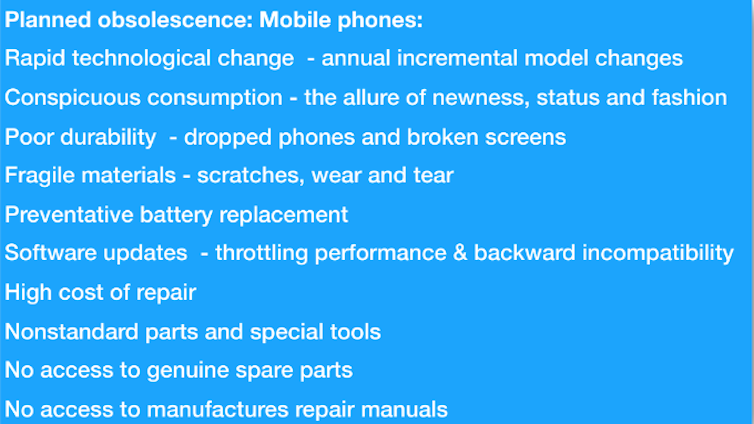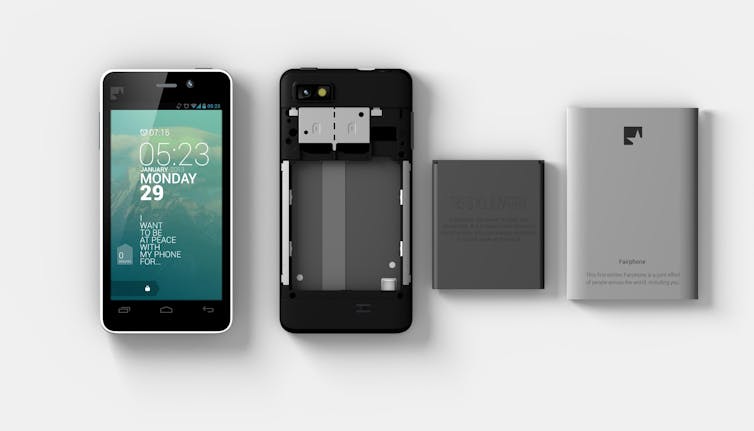if you really, truly need a new phone, buy one with replaceable parts
- Written by Miles Park, Senior Lecturer, Industrial Design, UNSW
Shopping can be confusing at the best of times, and trying to find environmentally friendly options makes it even more difficult. Our Sustainable Shopping series asks experts to provide easy eco-friendly guides to purchases big and small. Send us your suggestions for future articles here.
Almost 90% of Australians own a smartphone, and almost 40% of us are expected to update our phone in the coming year.
The most sustainable mobile phone is actually the phone you already own! This is because manufacturing a phone has far more environmental impact than using it.
The circuit board, display and battery are primarily responsible for your phone’s environmental impacts. These contain valuable minerals such as cobalt, gold, silver, palladium and tin. Huge amounts of ore, processing and energy are required to yield small amounts of these materials.
Read more: Don't chuck that old mobile phone, there's gold in there
Mining impacts, especially in unregulated areas, can result in land and agricultural degradation, heavy metal pollution of water, soil and air, and human rights and social impacts.
 More than 40 refined metals and elements are needed to make a phone.
from www.shutterstock.com
More than 40 refined metals and elements are needed to make a phone.
from www.shutterstock.com
According to Apple, manufacturing makes up 77% of the firm’s carbon footprint, with 17% attributed to usage and the remainder to transport, recycling and facilities. This percentage is generally consistent with other smartphone manufactures.
 Greenhouse emissions breakdown for an iPhone 8.
Apple
Greenhouse emissions breakdown for an iPhone 8.
Apple
There is estimated to be more than one active mobile phone for every person in the world. Cumulatively, this takes up many resources and has serious environmental and social impacts.
Considering a phone’s lifespan
Planned obsolescence is a design feature of most smartphones.
This strategy is nothing new. Back in 1954, the American industrial designer Brooks Stevens encouraged manufacturers to deliberately design products that would become obsolete long before they broke, as a way to boost sales. He encouraged incremental annual design updates – “a little newer, a little better, and a little sooner than necessary”.
In addition to fashion obsolescence, physical attributes also play a key role. Diminishing battery performance, poor durability, deteriorating appearance, and poor repairability can all persuade us to replace our phones sooner than necessary.
 Author provided
A case in point is the lithium-ion battery in your phone, which declines in performance as it ages. Lithium-ion batteries are usually only good for a specified number of charging and discharging cycles, so they typically require replacement after a few years. Yet most phone batteries are designed in a way that prevents user replacement and discourages servicing.
Apple even recently admitted that it has been “throttling” the performance of certain iPhones due to reduced battery performance. In fairness, Apple said that this was done to prevent the phone from unexpected shutdowns, and has now dramatically cut the cost of its battery replacement service for recent iPhone models.
Extending a phone’s lifespan from one to four years can decrease its environmental impact by about 40%. Unfortunately, most manufacturers actively discourage users from replacing the battery, or any other internal component, by using tamper-resistant fasteners or strong adhesives. This is rather like fitting a car with a set of tyres that are designed never to be removed and replaced.
iFixit is a notable source for free smartphone repair manuals, and its organisers have advocated for right-to-repair legislation that would require manufacturers to give owners and independent repairers access to replacement parts and technical information.
Meanwhile, there are some simple ways you can get around your phone’s inbuilt limitations, such as:
ensuring you maximise its battery life
fitting a screen protector, so a smashed or scratched screen doesn’t prematurely end your phone’s career.
Read more:
Explainer: how to extend your phone's battery life
What are the most sustainable phones on the market?
But say you’ve decided that you genuinely do need a new phone. What next?
You could consider buying a refurbished phone. They are often indistinguishable from an equivalent new phone and will save you money too.
Whether buying new or used, try to choose a model that is easy to repair or upgrade. iFixit scores various phones’ repairability, awarding points for upgradability, use of non-proprietary tools for servicing, and replaceability of individual components.
Greenpeace’s annual Guide to Greener Electronics, meanwhile, assesses the use of energy, resource and chemicals for different phone models, as well as supply-chain management.
This analysis found that, of the major manufacturers, Apple led the field when it comes to environmental performance.
But another, lesser-known brand scored higher still. The standout was the Fairphone 2, made by a small Dutch company which claims to have created the world’s first ethical, modular smartphone. It is currently only available in Europe, although it is reportedly compatible with other countries’ phone networks.
Author provided
A case in point is the lithium-ion battery in your phone, which declines in performance as it ages. Lithium-ion batteries are usually only good for a specified number of charging and discharging cycles, so they typically require replacement after a few years. Yet most phone batteries are designed in a way that prevents user replacement and discourages servicing.
Apple even recently admitted that it has been “throttling” the performance of certain iPhones due to reduced battery performance. In fairness, Apple said that this was done to prevent the phone from unexpected shutdowns, and has now dramatically cut the cost of its battery replacement service for recent iPhone models.
Extending a phone’s lifespan from one to four years can decrease its environmental impact by about 40%. Unfortunately, most manufacturers actively discourage users from replacing the battery, or any other internal component, by using tamper-resistant fasteners or strong adhesives. This is rather like fitting a car with a set of tyres that are designed never to be removed and replaced.
iFixit is a notable source for free smartphone repair manuals, and its organisers have advocated for right-to-repair legislation that would require manufacturers to give owners and independent repairers access to replacement parts and technical information.
Meanwhile, there are some simple ways you can get around your phone’s inbuilt limitations, such as:
ensuring you maximise its battery life
fitting a screen protector, so a smashed or scratched screen doesn’t prematurely end your phone’s career.
Read more:
Explainer: how to extend your phone's battery life
What are the most sustainable phones on the market?
But say you’ve decided that you genuinely do need a new phone. What next?
You could consider buying a refurbished phone. They are often indistinguishable from an equivalent new phone and will save you money too.
Whether buying new or used, try to choose a model that is easy to repair or upgrade. iFixit scores various phones’ repairability, awarding points for upgradability, use of non-proprietary tools for servicing, and replaceability of individual components.
Greenpeace’s annual Guide to Greener Electronics, meanwhile, assesses the use of energy, resource and chemicals for different phone models, as well as supply-chain management.
This analysis found that, of the major manufacturers, Apple led the field when it comes to environmental performance.
But another, lesser-known brand scored higher still. The standout was the Fairphone 2, made by a small Dutch company which claims to have created the world’s first ethical, modular smartphone. It is currently only available in Europe, although it is reportedly compatible with other countries’ phone networks.
 The Fairphone, described by its makers as the world’s first ethical phone.
Fairphone/flickr, CC BY
What to do with your old phone?
OK, so you bought a new phone! The next question is what to do with the old one. One in seven of us will keep an old phone, even if it doesn’t work. According to a survey commissioned by eBay in Australia, that equates to A$8.6billion worth of smartphones gathering dust in drawers. Popular models of smartphones will have resale value even if they are broken.
The final end-of-life option is to recycle your mobile phone through a retailer that offers a recycling service. As mobile phones make up one of the largest categories of e-waste, it is important that you recycle your phone responsibly to ensure that valuable material can be recovered and toxic materials properly managed. Unfortunately, too much of our e-waste is not properly documented and is being exported to emerging economies, where it is recycled in sometimes appalling conditions.
A final tip: if you sell or recycle your old phone, ensure that you have removed the old SIM, erased all data, and reset the phone.
The Fairphone, described by its makers as the world’s first ethical phone.
Fairphone/flickr, CC BY
What to do with your old phone?
OK, so you bought a new phone! The next question is what to do with the old one. One in seven of us will keep an old phone, even if it doesn’t work. According to a survey commissioned by eBay in Australia, that equates to A$8.6billion worth of smartphones gathering dust in drawers. Popular models of smartphones will have resale value even if they are broken.
The final end-of-life option is to recycle your mobile phone through a retailer that offers a recycling service. As mobile phones make up one of the largest categories of e-waste, it is important that you recycle your phone responsibly to ensure that valuable material can be recovered and toxic materials properly managed. Unfortunately, too much of our e-waste is not properly documented and is being exported to emerging economies, where it is recycled in sometimes appalling conditions.
A final tip: if you sell or recycle your old phone, ensure that you have removed the old SIM, erased all data, and reset the phone.
Authors: Miles Park, Senior Lecturer, Industrial Design, UNSW





